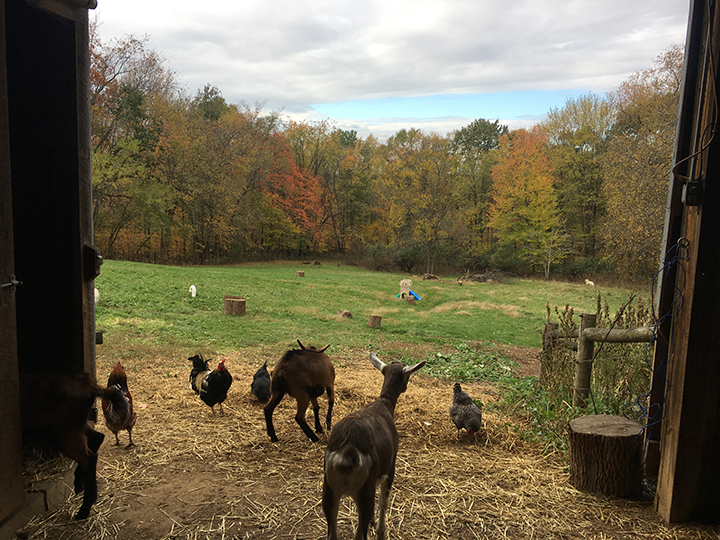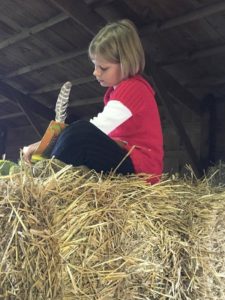Five years ago this month, I was bringing our family’s fifth baby into the world. We were living in a nice, suburban neighborhood with a big, fenced in yard and a fabulous wooden playset flanked with six raised bed gardens. My friends called me Martha because I liked to grow food and cook from scratch. I liked to sew and craft and just make things in general. Little did I know what that was about to become.
When that baby #5 was six weeks old, my husband got transferred and my family moved from the suburbs in SW Ohio, to a town I’d never heard of in NE Ohio…ironically only about 20 minutes away from Lehman’s Hardware Store. We went from neighborhoods to wide open farmland. In a matter of weeks, we were surrounded by people with acres and acres of crops and animals and people who not only grew and raised their own dinners, but canned, cooked, and knew how to store basically everything for the winter.
It was no surprise that within a few weeks of trading in fenced in yard to fenced in pastures on our homestead that I acquired laying chickens (and first learned that there was a difference between egg layers and chickens raised for meat! I never knew! But that’s a different post.) I not only hadn’t grown up in the great wide open of the country, I didn’t have any desire to. I wasn’t opposed to it, but I wasn’t looking for it.
But I found myself living the life I never knew I always wanted.
We had just over five acres, a barn, and a beautiful fenced pasture just waiting to be used. I started reading (basically anything from Joel Salatin, as well as books about specific tasks or animals) researching, watching YouTube videos, befriending other homesteaders, anyone who’d ever even seen a farm animal. I wanted to know it all. From Justin Rhodes, to Arms Family Homestead, to Lumnah Acres, I loved watching and learning. In addition to being knowledgeable, the homesteading community is tight knit and so supportive of learning!
So I dug in and learned as much as I could. I learned that we have a great spot for a beautiful garden, but I had to learn in-ground gardening versus the raised bed square foot gardening that I was used to. I learned that while I loved the antics of my free range layer chickens, I didn’t love the mess they made all over my sidewalk and porch, or when they would lay eggs other than in the nesting boxes. A daily Easter egg hunt wasn’t my idea of fun.
Over time, I learned that while I have room for a cow, I don’t want one (again with the poop), and while I would consider sheep in the future, I didn’t want to start there.
After chickens and a garden, we decided to add goats to our homestead. There were six important things I learned about goats in my first few years of owning them:
What to Know Before Raising Goats
#1. Know what kind of goat you want.
Are you looking for something to keep back weeds and brush on your property? (They’re great at that! Goats are browsers, not grazers. They prefer to eat the gnarly stuff that grows at their shoulder height or higher. They love poison ivy (so avoid kissing them in the summer), briars, spiky weeds, all the stuff we want to get rid of.) Are you looking for meat? Or do you want to milk one to two times a day?
#2. Goats do not eat just anything.
That joke about eating a tin can? Total myth. Goats will nibble just about anything: the can, your shirt, shoelaces…anything. On the contrary, they have quite sensitive digestive systems and you need to make sure they’re getting what they need to regulate it. They are ruminants, meaning they have multiple stomachs and chew cud. Sheep and cows are other ruminant animals. Their gut flora needs to stay balanced or they will get quite sick. Goats benefit from mineral supplements and even just baking soda available to them to nibble will help keep their rumen in balance. Male goats and female goats have slightly different needs. They mostly need hay, water, and access to pasture, but just like people are individuals, goats are as well, and learning the needs of your individual goats will be key.
#3. Find a mentor.
Ideally, it would be someone close by, so you could see their set up and they could help you in a time of need. However, in the day and age of social media, having someone who can answer questions and give you suggestions is priceless. I call my mentors my Goat Yodas because they are very wise and sometimes their advice seems a little confusing, but they’re always right in the end.
#4. Goats cannot be alone.
They are herd animals and have to have a buddy. They need at least one other goat in order to be happy and peaceful. Keep in mind you can’t just get a little boy and a little girl because you eventually want to breed. You will have to keep the buck away from the doe until she’s old enough to breed and after the babies are born, so they’ll both need a buddy. If you’re not breeding, you could do a wether (castrated male) and a doe if they’re going to be housed together. You will be tempted to get all the goats, but fight the urge, because…..
#5. Start small and young.
It’s tempting to buy a pregnant doe or an adult in milk, or even an adult ready to breed. If you’re looking for milk, buying a baby and having to wait for almost two years to have milk seems like an eternity, but from experience, buying a pregnant mom who didn’t have good prenatal care leads to sick babies who might not make it. On a less sad note, it just simplifies the learning process for you. You can spend your first year enjoying your goats and learning about them. You can learn their personalities and be confident of their care. You can know as much of their history as possible and know that they have always received the best care whether you’re breeding or not. Bonus: bouncing babies are the cutest things on the planet!
#6. Buy from a trusted source.
Registered doesn’t always mean healthy, but it does mean that people care very much about bloodlines and goat health. If possible, see where they’ve been raised and really look over the goats. Check their Famacha Score as well as their hooves, bottom, and teeth. Before you go, look up what quality udder attachment looks like as well as what a healthy goat overall should be.

































We are just getting started. I am nervous, and excited at the same time. Thanks for the information.
[…] my teenage obsession with cows, the thought of buying such a huge animal was so intimidating to me. Goats, on the other hand, seemed far more doable. I didn’t know what I was doing, so I read everything […]